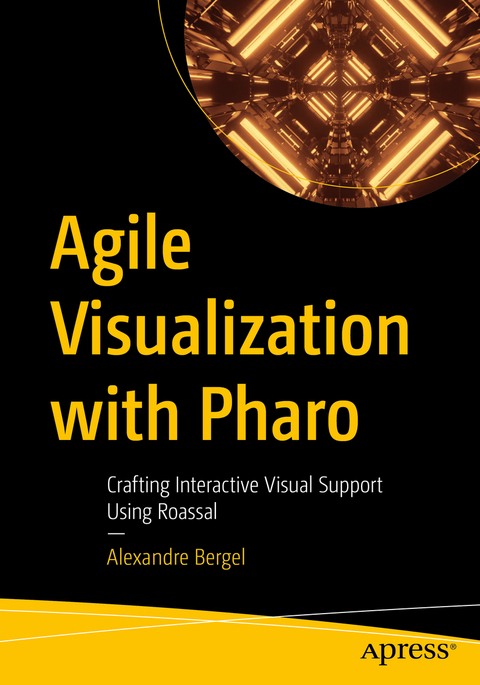
Agile Visualization with Pharo
Crafting Interactive Visual Support Using Roassal
Seiten
2021
|
1st ed.
Apress (Verlag)
978-1-4842-7160-5 (ISBN)
Apress (Verlag)
978-1-4842-7160-5 (ISBN)
Use the Pharo interactive development environment to significantly reduce the cost of creating interactive visualizations. This book shows how Pharo leverages visualization development against traditional frameworks and toolkits.
Agile Visualization with Pharo focuses on the Roassal visualization engine and first presents the basic and necessary tools to visualize data, including an introduction to the Pharo programming language. Once you’ve grasped the basics, you’ll learn all about the development environment offered by Roassal. The book provides numerous ready-to-use examples. You’ll work on several applications, including visualizing the training phase of reinforcement learning (a powerful machine learning algorithm) and generating software visualizations from GitHub.
This book covers aspects that are relevant for engineers and academics to successfully design and implement interactive visualizations.
What You Will Learn
Implement agile data visualization using the Pharo programming language
Chart, plot, and curve using Grapher
Build and draw graphs using Mondrian
Implement reinforcement learning (Q-Learning, from scratch) and use visualizations to monitor learning and state exploration
Use GitHub Action to generate software visualizations (UML class diagram, test coverage) at each commit
Who This Book Is For
Programmers with some prior exposure to data visualization and computer vision who may be new to the Pharo programming language. This book is also for those with some Pharo experience looking to apply it to data visualization.
Agile Visualization with Pharo focuses on the Roassal visualization engine and first presents the basic and necessary tools to visualize data, including an introduction to the Pharo programming language. Once you’ve grasped the basics, you’ll learn all about the development environment offered by Roassal. The book provides numerous ready-to-use examples. You’ll work on several applications, including visualizing the training phase of reinforcement learning (a powerful machine learning algorithm) and generating software visualizations from GitHub.
This book covers aspects that are relevant for engineers and academics to successfully design and implement interactive visualizations.
What You Will Learn
Implement agile data visualization using the Pharo programming language
Chart, plot, and curve using Grapher
Build and draw graphs using Mondrian
Implement reinforcement learning (Q-Learning, from scratch) and use visualizations to monitor learning and state exploration
Use GitHub Action to generate software visualizations (UML class diagram, test coverage) at each commit
Who This Book Is For
Programmers with some prior exposure to data visualization and computer vision who may be new to the Pharo programming language. This book is also for those with some Pharo experience looking to apply it to data visualization.
Alexandre Bergel is a contributor to the Pharo programming language and an assistant professor at the University of Chile. He does research in software engineering and programming using Pharo and other programming languages with applications in data visualization, agile methodology, and more.
1: Introduction.- 2: Quick Start.- 3: Pharo in a Nutshell.- 4: Agile Visualization.- 5: Overview of Rossal.- 6: The Rossal Canvas.- 7: Shapes.- 8: Line Builder.- 9: Shape Composition.- 10: Normalizing and Scaling Values.- 11: Interactions.- 12: Layouts.- 13: Integration in the Inspector.- 14: Reinforcement Learning.- 15: Generating Visualizations from GitHub.
| Erscheinungsdatum | 06.12.2021 |
|---|---|
| Zusatzinfo | 103 Illustrations, color; 35 Illustrations, black and white; XI, 266 p. 138 illus., 103 illus. in color. |
| Verlagsort | Berkley |
| Sprache | englisch |
| Maße | 178 x 254 mm |
| Themenwelt | Mathematik / Informatik ► Informatik ► Programmiersprachen / -werkzeuge |
| Informatik ► Software Entwicklung ► User Interfaces (HCI) | |
| Informatik ► Theorie / Studium ► Compilerbau | |
| Mathematik / Informatik ► Mathematik ► Graphentheorie | |
| ISBN-10 | 1-4842-7160-2 / 1484271602 |
| ISBN-13 | 978-1-4842-7160-5 / 9781484271605 |
| Zustand | Neuware |
| Haben Sie eine Frage zum Produkt? |
Mehr entdecken
aus dem Bereich
aus dem Bereich
Aus- und Weiterbildung nach iSAQB-Standard zum Certified Professional …
Buch | Hardcover (2023)
dpunkt Verlag
CHF 48,85
Lean UX und Design Thinking: Teambasierte Entwicklung …
Buch | Hardcover (2022)
dpunkt (Verlag)
CHF 48,85
Wissensverarbeitung - Neuronale Netze
Buch | Hardcover (2023)
Carl Hanser (Verlag)
CHF 48,95


